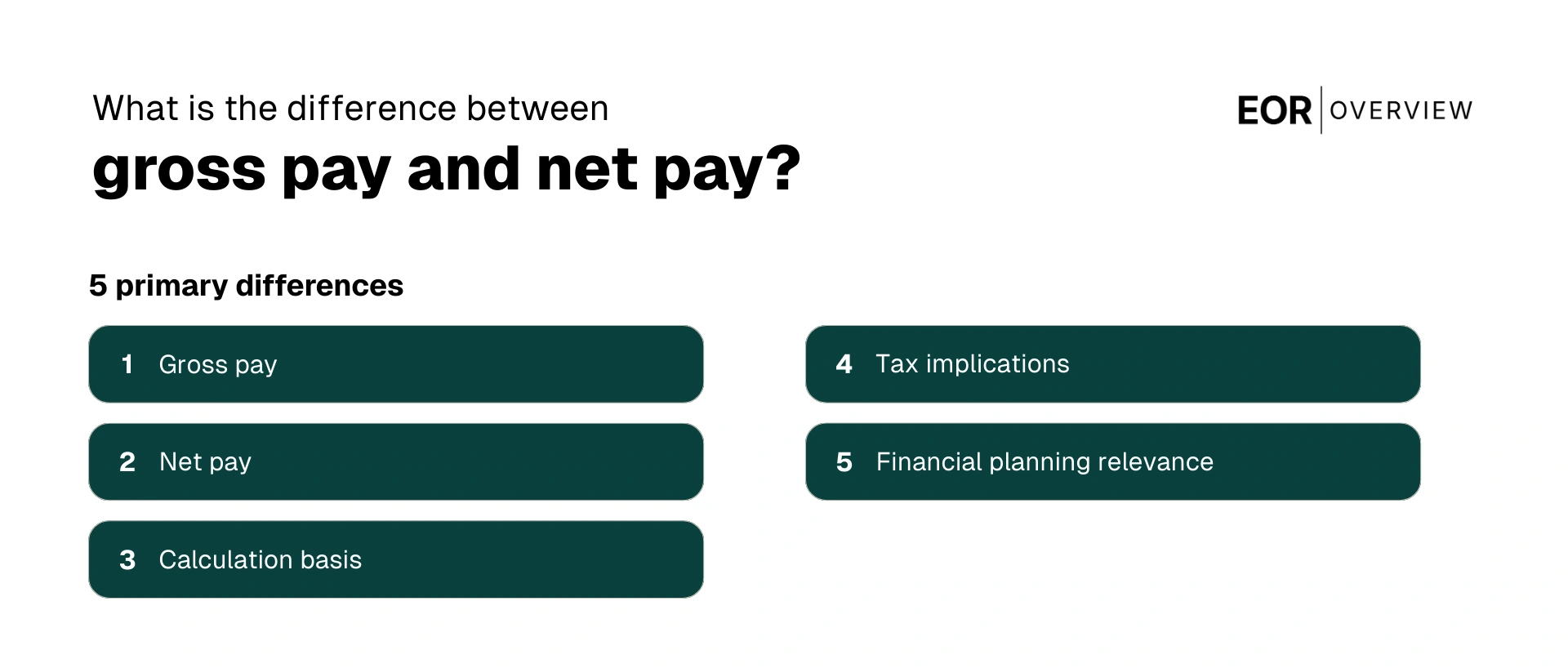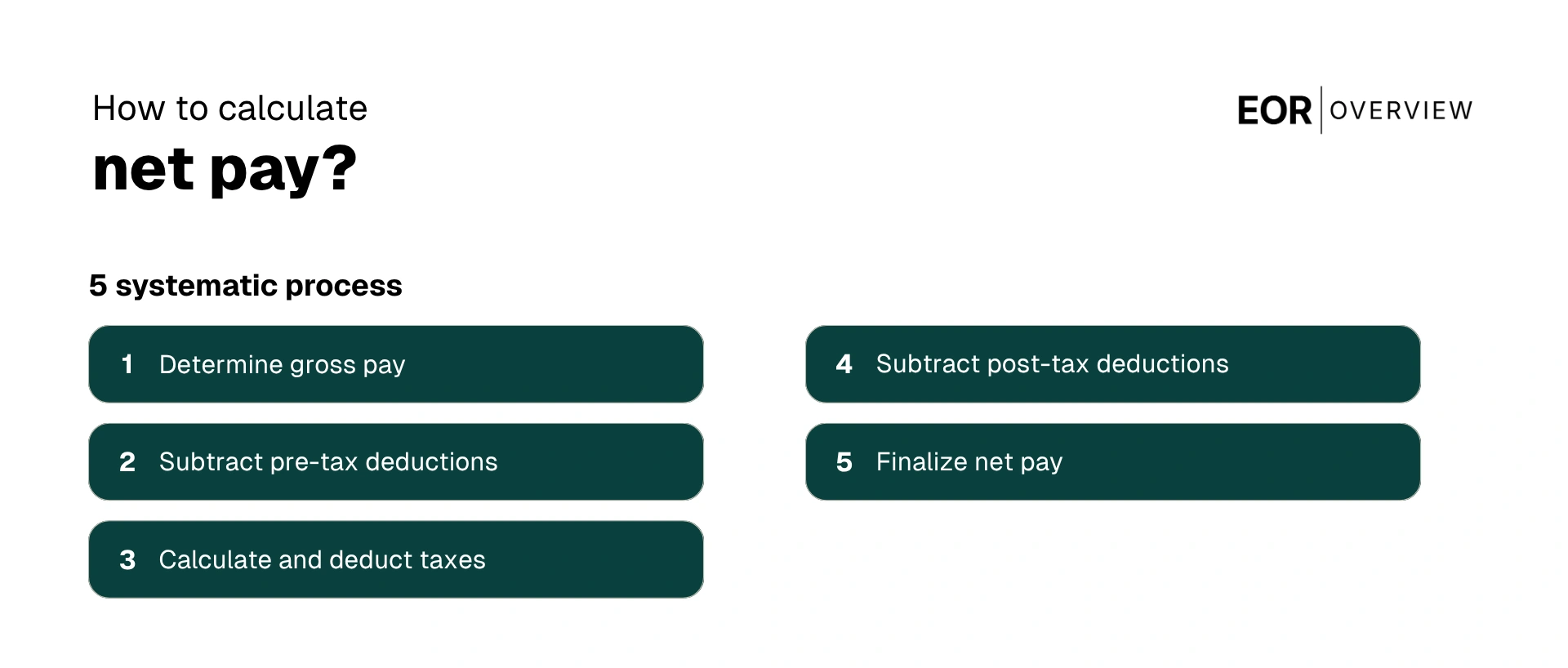Net pay is the amount an employee receives after all payroll taxes have been subtracted from their gross pay, providing the true picture of take-home compensation.
For HR and hiring managers, accurately calculating and communicating net pay is essential for maintaining compliance, ensuring employee satisfaction, and effectively managing company finances.
What is net pay?
Net pay represents the final amount a salaried employee receives in their paycheck after all mandatory and voluntary deductions have been subtracted from their gross earnings. It's the actual amount of money that reaches an employee's bank account or paycheck, which they can use for their living expenses, savings, and discretionary spending.
As an employer or HR professional, understanding net pay is fundamental to transparent compensation practices. It forms the basis of employees' financial planning and directly impacts their perception of job satisfaction and financial well-being.

What is the difference between gross pay and net pay?
The distinction between gross pay and net pay is essential for both payroll processing and employee financial literacy. While they're related concepts, they represent very different aspects of employee compensation.
Gross pay is the total amount earned before any deductions are taken out. It includes the employee's base salary or hourly wages, overtime pay, bonuses, commissions, and any other forms of compensation before taxes and other withholdings.
Net pay is the amount an employee actually receives after all payroll deductions taken. It represents the 'take-home pay' that appears on their paycheck or is deposited into their bank account.
Calculation basis differs significantly - gross pay calculations focus on earnings and additions, while net pay calculations center on what remains after subtractions.
Tax implications vary greatly - employees pay taxes based on their gross income, but budget their lives based on their net income.
Financial planning relevance is different - gross pay matters for loan applications and credit assessments, while net pay determines actual spending power.
For hiring managers, understanding this distinction is crucial when discussing compensation packages with candidates. While gross salary figures may look impressive in offer letters, candidates are increasingly savvy about calculating their expected net pay to evaluate if the compensation truly meets their financial needs.
What can reduce net pay?
Mandatory government deductions, retirement contributions, health insurance premiums, garnishments, and voluntary benefits all impact the final take home amount. These deductions are listed in detail below.
Mandatory government deductions include federal income tax withholding based on W-4 information, Social Security tax (6.2% of wages up to the annual limit), Medicare tax (1.45% of all wages with additional amounts for high earners), and state and local income taxes where applicable.
Retirement contributions typically include 401(k), 403(b), or other retirement plan contributions, which are often pre-tax deductions that reduce taxable income while building retirement savings.
Health insurance premiums cover employee portions of medical, dental, and vision insurance plans, which may be deducted pre-tax depending on the employer's benefits structure.
Garnishments and legal obligations such as child support, alimony payments, student loan repayments, and tax levies can be legally required deductions that employers must process.
Voluntary benefit deductions might include flexible spending accounts (FSAs), health savings accounts (HSAs), supplemental insurance premiums, charitable contributions, and company-specific programs like stock purchase plans.
⚠️ Warning: Employers must ensure all deductions are properly authorized and documented. Unauthorized deductions can lead to legal issues, Department of Labor violations, and damaged employee trust.

How to calculate net pay?
Calculating net pay follows a systematic process that HR and payroll professionals must execute with precision. The calculation begins with gross pay and proceeds through several deduction steps.
Step 1: Determine gross pay by calculating all earnings for the pay period, including regular wages, overtime, bonuses, and commissions.
Step 2: Subtract pre-tax deductions such as health insurance premiums, retirement contributions, and flexible spending accounts, which reduce the taxable income amount.
Step 3: Calculate and deduct taxes including federal income tax (based on W-4 information and tax tables), Social Security tax, Medicare tax, and applicable state and local taxes.
Step 4: Subtract post-tax deductions including garnishments, after-tax benefits, union dues, and any other authorized post-tax withholdings.
Step 5: Finalize net pay by confirming the remaining amount, which becomes the employee's take-home pay.
The formula can be expressed as: Net Pay = Gross Pay - Pre-tax Deductions - Taxes - Post-tax Deductions. While the concept is straightforward, the execution requires attention to detail and knowledge of current tax regulations, which can change annually.
Why employers need to know their employees' net pay?
Understanding employees' net pay is not just a technical requirement but a strategic advantage for employers. It impacts multiple aspects of workforce management and organizational planning.
Compliance and legal requirements mandate accurate calculation and reporting of employee compensation, with potential penalties for errors in tax withholding or mandatory deductions.
Budgeting and financial planning for the organization requires clear visibility into true labor costs, including both gross pay and the employer's portion of taxes and benefits.
Compensation strategy effectiveness can only be properly evaluated when employers understand the relationship between offered gross salaries and resulting net pay in their specific location and industry.
Employee satisfaction and retention are directly influenced by net pay, as employees make financial and career decisions based on their actual take-home compensation, not gross figures.
Recruitment competitiveness depends on offering packages that translate to attractive net pay amounts compared to market alternatives, especially for tech and finance roles.
Many organizations now provide total compensation statements that clearly illustrate both gross and net pay, along with the value of employee benefits, to help employees understand their complete compensation package. This transparency builds trust and helps justify the gap between gross and net figures.
For employees, what does net pay mean?
For employees, net pay represents their actual financial reality and purchasing power. It's the foundation of their personal budgeting, financial planning, and assessment of job value.
Budgeting and financial planning starts with net pay, as it's the actual amount available for living expenses, debt repayment, and savings goals.
Job offer evaluation increasingly focuses on projected net pay rather than gross salary figures, especially among financially savvy professionals in tech and finance sectors.
Benefits value assessment helps employees understand how much of their compensation comes in forms other than cash, potentially offsetting a lower-than-expected net pay.
Tax planning opportunities become apparent when employees understand the relationship between their deductions and their net pay, potentially motivating adjustments to withholding or pre-tax contribution strategies.
Financial literacy development is enhanced when employees regularly review their pay stubs and understand each deduction's purpose and impact.
HR managers can support employees by providing educational resources about net pay calculations and offering tools that help visualize how different benefit elections might affect take-home pay. This education is particularly valuable during open enrollment periods when employees make benefit decisions that will impact their net pay throughout the year.
What are the tools and services to assist with calculating net pay?
Modern HR and payroll professionals have access to numerous tools and services that streamline and automate net pay calculations. These solutions range from basic calculators to sophisticated integrated systems.
Payroll software platforms like ADP, Gusto, and Paychex offer comprehensive solutions that automatically calculate net pay while ensuring compliance with current tax laws and regulations.
Online paycheck calculators provided by government agencies and financial websites allow quick estimations of net pay based on location, salary, and basic deduction information.
HRIS (Human Resource Information Systems) such as Workday, BambooHR, and Oracle HCM integrate payroll processing with broader HR functions for a more holistic approach to compensation management.
Tax withholding tools from the IRS and state tax authorities help determine proper withholding amounts to avoid significant discrepancies between expected and actual net pay.
Benefits administration platforms like Zenefits and Rippling show employees how benefit elections will impact their net pay before they make final choices.
For startups and growing companies, selecting the right combination of these tools is crucial for scaling operations efficiently. The ideal solution should grow with your organization, accommodate increasingly complex compensation structures, and integrate with other business systems.
As tax laws and benefit structures evolve, staying current with net pay calculation requirements is an ongoing responsibility. Regular audits of your payroll processes can prevent costly compliance issues and ensure your compensation strategy remains competitive in attracting and retaining top talent.

